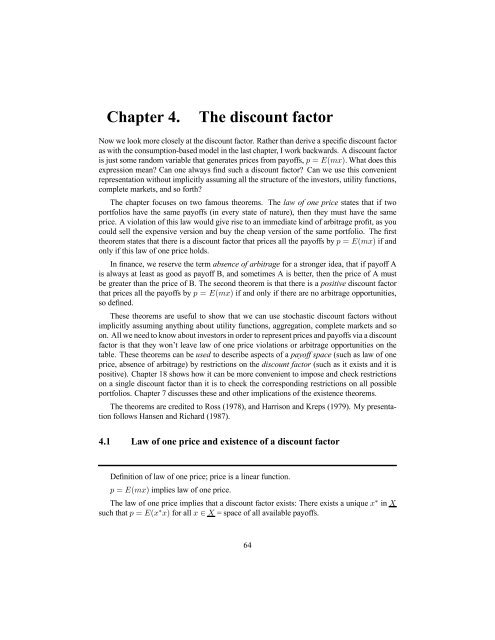Asset Pricing John H. Cochrane June 12, 2000
Asset Pricing John H. Cochrane June 12, 2000
Asset Pricing John H. Cochrane June 12, 2000
Create successful ePaper yourself
Turn your PDF publications into a flip-book with our unique Google optimized e-Paper software.
Chapter 4. The discount factor<br />
Now we look more closely at the discount factor. Rather than derive a specific discount factor<br />
as with the consumption-based model in the last chapter, I work backwards. A discount factor<br />
is just some random variable that generates prices from payoffs, p = E(mx). What does this<br />
expression mean? Can one always find such a discount factor? Can we use this convenient<br />
representation without implicitly assuming all the structure of the investors, utility functions,<br />
complete markets, and so forth?<br />
The chapter focuses on two famous theorems. The law of one price states that if two<br />
portfolios have the same payoffs (in every state of nature), then they must have the same<br />
price. A violation of this law would give rise to an immediate kind of arbitrage profit, as you<br />
could sell the expensive version and buy the cheap version of the same portfolio. The first<br />
theorem states that there is a discount factor that prices all the payoffs by p = E(mx) if and<br />
only if this law of one price holds.<br />
In finance, we reserve the term absence of arbitrage for a stronger idea, that if payoff A<br />
is always at least as good as payoff B, and sometimes A is better, then the price of A must<br />
be greater than the price of B. The second theorem is that there is a positive discount factor<br />
that prices all the payoffs by p = E(mx) if and only if there are no arbitrage opportunities,<br />
so defined.<br />
These theorems are useful to show that we can use stochastic discount factors without<br />
implicitly assuming anything about utility functions, aggregation, complete markets and so<br />
on. All we need to know about investors in order to represent prices and payoffs via a discount<br />
factor is that they won’t leave law of one price violations or arbitrage opportunities on the<br />
table. These theorems can be used to describe aspects of a payoff space (such as law of one<br />
price, absence of arbitrage) by restrictions on the discount factor (such as it exists and it is<br />
positive). Chapter 18 shows how it can be more convenient to impose and check restrictions<br />
on a single discount factor than it is to check the corresponding restrictions on all possible<br />
portfolios. Chapter 7 discusses these and other implications of the existence theorems.<br />
The theorems are credited to Ross (1978), and Harrison and Kreps (1979). My presentation<br />
follows Hansen and Richard (1987).<br />
4.1 Law of one price and existence of a discount factor<br />
Definition of law of one price; price is a linear function.<br />
p = E(mx) implies law of one price.<br />
The law of one price implies that a discount factor exists: There exists a unique x∗ in X<br />
such that p = E(x∗x) for all x ∈ X = space of all available payoffs.<br />
64
















